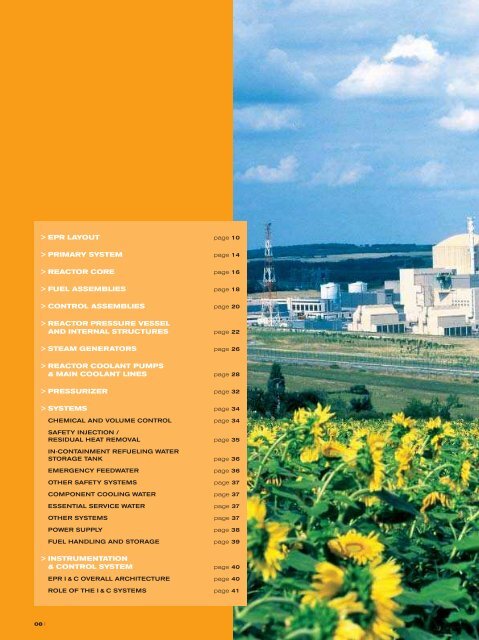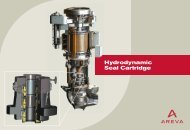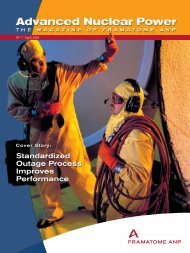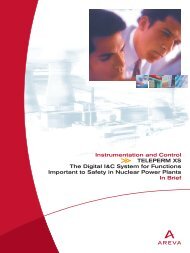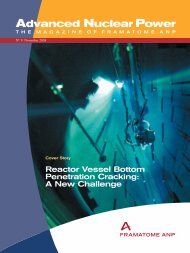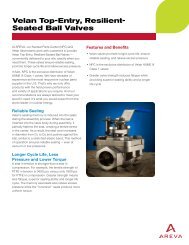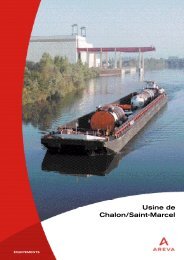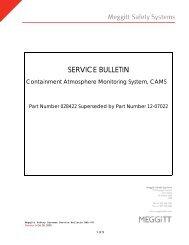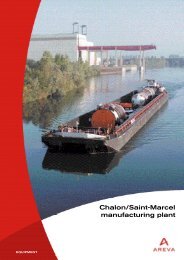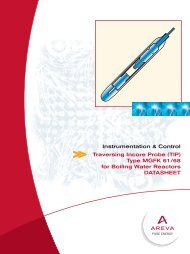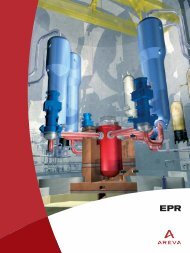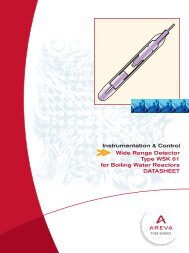Areva EPR
Areva EPR
Areva EPR
You also want an ePaper? Increase the reach of your titles
YUMPU automatically turns print PDFs into web optimized ePapers that Google loves.
■ <strong>EPR</strong> NUCLEAR ISLAND<br />
REACTOR CORE<br />
†<br />
The reactor core contains the fuel material in which the fission<br />
reaction takes place, releasing energy. The reactor internal<br />
structures serve to physically support this fissile material,<br />
control the fission reaction and channel the coolant.<br />
The core is cooled and moderated by light water at a pressure of<br />
155 bar and a temperature in the range of 300 °C. The coolant<br />
contains soluble Boron as a neutron absorber. The Boron<br />
concentration in the coolant is varied as required to control relatively<br />
slow reactivity changes, including the effects of fuel burnup.<br />
Additional neutron absorbers (Gadolinium), in the form of burnable<br />
absorber-bearing fuel rods, are used to adjust the initial reactivity<br />
and power distribution. Instrumentation is located inside and outside<br />
the core to monitor its nuclear and thermal-hydraulic performance<br />
and to provide input for control functions.<br />
The <strong>EPR</strong> core consists of 241 fuel assemblies. For the first core,<br />
assemblies are split into four groups with different enrichments (two<br />
groups with the highest enrichment, one of them with Gadolinium).<br />
For reload cores, the number and characteristics of the fresh<br />
assemblies depend on the type of fuel management scheme<br />
selected, notably cycle length and type of loading patterns. Fuel<br />
cycle lengths up to 24 months, IN-OUT and OUT-IN fuel<br />
management are possible. The <strong>EPR</strong> is designed for flexible operation<br />
with UO 2 fuel and/or MOX fuel. The main features of the core and its<br />
operating conditions have been selected to obtain not only high<br />
thermal efficiency of the plant and low fuel cycle costs, but also<br />
extended flexibility for different fuel cycle lengths and a high level of<br />
maneuverability.<br />
Core instrumentation<br />
The core power is measured using the ex-core instrumentation, also<br />
utilized to monitor the process to criticality.<br />
The reference instrumentation to monitor the power distribution in<br />
the core is an “aeroball” system. Vanadium balls are periodically<br />
inserted in the core. Their activation level is measured, giving values<br />
of the local neutron flux to construct the three-dimensional power<br />
map of the core.<br />
The fixed in-core instrumentation consists of neutron detectors and<br />
thermocouples to measure the neutron flux distribution in the core<br />
and temperature distribution at the core outlet.<br />
The whole in-core instrumentation package is introduced from the<br />
top of the reactor pressure vessel head. Therefore, the bottom of<br />
the reactor pressure vessel is free from any penetration.<br />
For additional information see the “Instrumentation and Control<br />
systems” chapter, page 42.<br />
The core design analyses demonstrate the feasibility of different<br />
types of fuel management schemes to meet the requirements<br />
expressed by the utility companies in terms of cycle length and fuel<br />
cycle economy (reload fraction, burnup), and to provide the core<br />
characteristics needed for sizing of the reactor systems. The nuclear<br />
analyses establish physical locations for control rods, burnable<br />
poison rods, and physical parameters such as fuel enrichments and<br />
Boron concentration in the coolant. The thermal-hydraulic analyses<br />
establish coolant flow parameters to ensure that adequate heat is<br />
transferred from the fuel to the reactor coolant.<br />
Isar 2 unit, Germany (KONVOI, 1,300 MWe): fuel loading operation.<br />
16 I


